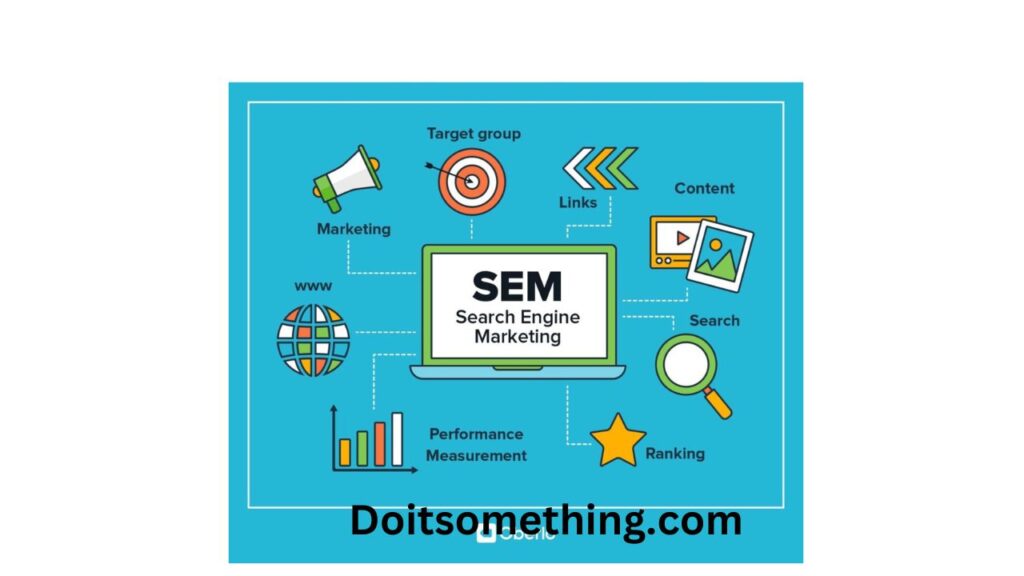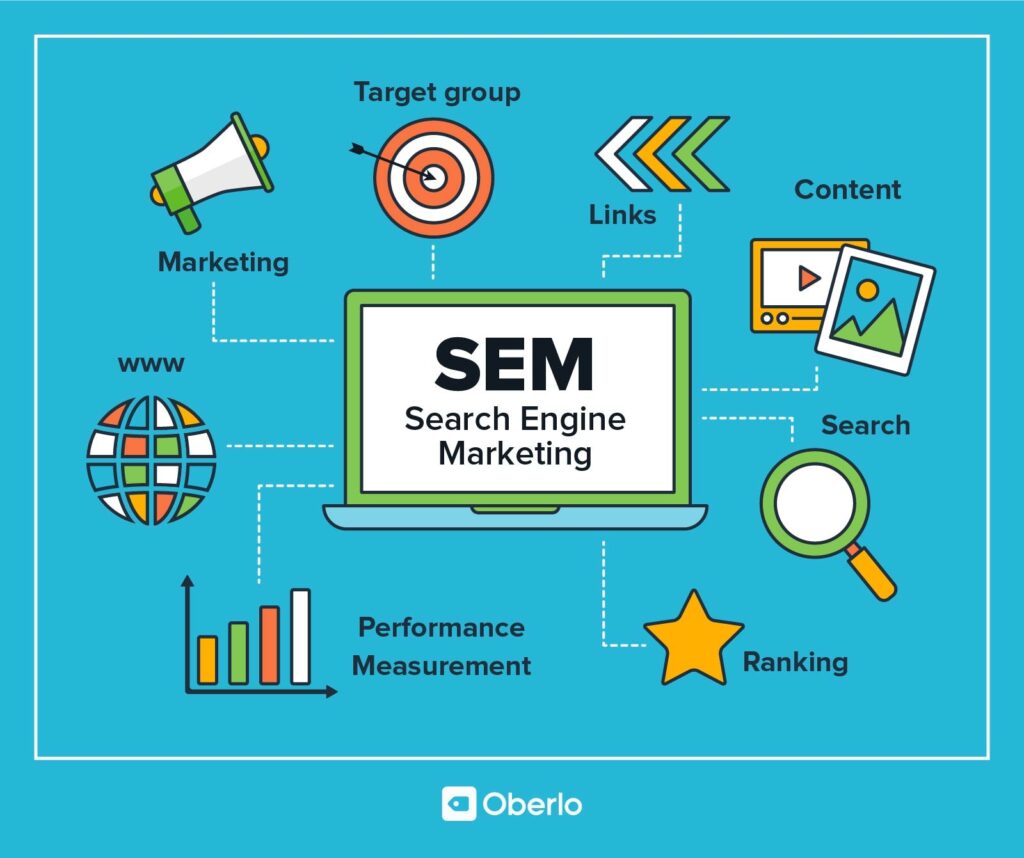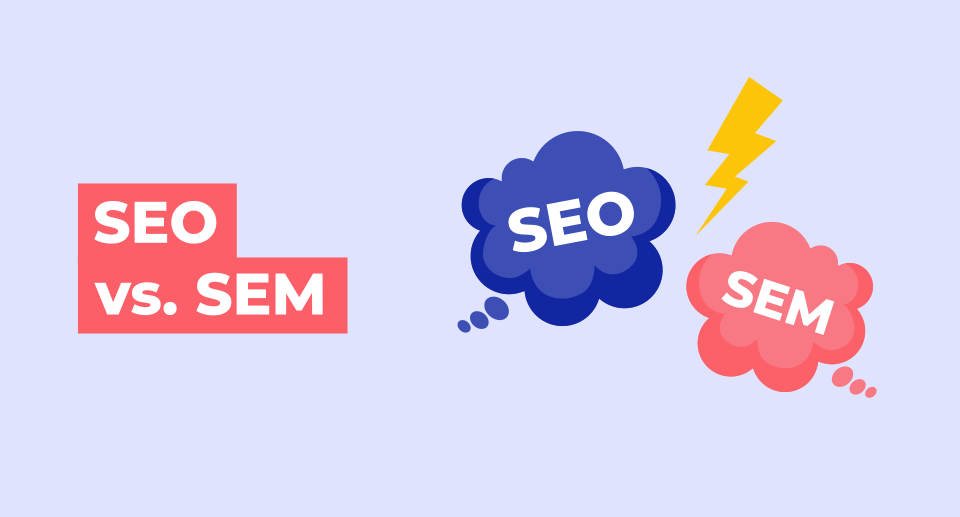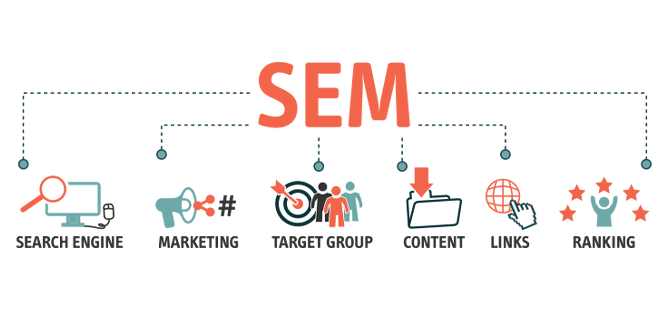A Complete Guide to Search Engine Marketing (SEM)

What is SEM
What is SEM
Did you know about What is SEM ? If yes then this article is for you. We will be discussing. Read on for more.
To reiterate, SEM stands for “Search Engine Marketing.” It is a digital marketing strategy that involves promoting a website or web page in search engine results pages (SERPs) through paid advertising. SEM primarily focuses on increasing visibility and driving traffic to a website by using paid search advertising.

The most common form of SEM is Pay-Per-Click (PPC) advertising, where advertisers bid on specific keywords relevant to their products or services. When a user searches for those keywords, the search engine displays the advertiser’s ad in the sponsored listings section of the search results. Advertisers only pay when someone clicks on their ad, hence the name “Pay-Per-Click.”
SEO vs. SEM
SEO (Search Engine Optimization) and SEM (Search Engine Marketing) are two distinct digital marketing strategies used to improve a website’s visibility on search engine results pages (SERPs). While they both aim to increase website traffic from search engines, they use different approaches and have unique characteristics:
- SEO (Search Engine Optimization):
- Definition: SEO is the practice of optimizing a website to improve its organic (non-paid) search engine rankings. The goal is to make the website more search engine-friendly, so it ranks higher in relevant search queries, ultimately driving organic, unpaid traffic.
- Methods: SEO involves various on-page and off-page optimization techniques, such as keyword research, content optimization, link building, website speed optimization, and user experience enhancement.
- Cost: While SEO doesn’t need direct payments to search engines for clicks, it does involve investing time, effort, and sometimes money in creating high-quality content and implementing optimization strategies.
- Results: SEO results take time to manifest, as search engines need to crawl and index the website’s changes. It may take weeks or months to see significant improvements in organic rankings and traffic.

SEM (Search Engine Marketing):
- Definition: SEM is a form of online advertising that promotes a website or web page through paid ads on search engine results pages. It involves bidding on specific keywords relevant to the business to display ads to users searching for those keywords.
- Methods: SEM primarily revolves around pay-per-click (PPC) advertising, where advertisers bid on keywords and create ad campaigns.
- Cost: Advertisers pay for each click on their ads, hence the term “pay-per-click.” The cost of SEM campaigns varies depending on the competitiveness of the keywords and the budget set by the advertiser.
- Results: SEM can produce immediate results, as ads are displayed as soon as the campaign is launched. It allows businesses to quickly drive targeted traffic to their websites and measure the performance of their ads through various metrics.
How SEM works
The process involves several steps and strategies to create and run effective SEM campaigns. Here’s how SEM works:
- Keyword Research: The first step in SEM is to conduct keyword research. Advertisers identify relevant keywords and phrases that users might use when searching for products, services, or information related to their business. These keywords are the foundation of the SEM campaign.
- Ad Creation: Advertisers create compelling and relevant ads that match the selected keywords. Each ad typically consists of a headline, ad copy, and a call-to-action (CTA). The goal is to make the ad enticing to users and encourage them to click on it.

- Bid Auction: SEM platforms, such as Google Ads or Microsoft Advertising, use an auction system to determine which ads will be displayed for specific search queries. Advertisers bid on the keywords they want to target, indicating the most amount they are willing to pay for a click on their ad.
- Ad Rank: Ad rank is a metric used by search engines to determine the order in which ads will appear on the SERPs. It is calculated based on the bid amount, ad quality, and expected click-through rate (CTR). Higher-quality ads with more relevant keywords and better user engagement are likely to achieve higher ad ranks.
- Cost-Per-Click (CPC) and Budget Control: Advertisers are only charged when someone clicks on their ad, not when the ad is displayed. This model is known as Cost-Per-Click (CPC). Advertisers can set daily or monthly budgets to control their spending on the SEM campaign.
Importance of SEM
Search Engine Marketing (SEM) is crucial for businesses and marketers due to several significant reasons:
- Increased Online Visibility: SEM allows businesses to immediately gain visibility on search engine results pages (SERPs) through paid ads. This increased visibility can help businesses reach a broader audience and compete with established competitors in the online space.
- Targeted Advertising: SEM enables precise targeting of potential customers based on specific keywords, demographics, location, device type, and other parameters. This targeted approach ensures that ads are shown to relevant users, increasing the chances of attracting qualified leads and customers.

- Cost Control: SEM platforms work on a pay-per-click (PPC) model, where advertisers only pay when someone clicks on their ads. This cost-per-click model allows businesses to control their advertising budget and divide resources based on performance.
- Measurable ROI: SEM provides detailed performance metrics, such as impressions, clicks, conversions, and costs. These metrics allow businesses to track the effectiveness of their campaigns, measure return on investment (ROI), and make data-driven decisions to optimize their marketing efforts.
- Brand Awareness: Even if users don’t click on the ads, they are exposed to the advertiser’s brand and message. Consistent visibility through SEM can help build brand awareness, recognition, and trust over time.
- Flexibility and Customization: SEM campaigns can be tailored to suit different business goals and marketing objectives. Advertisers can create many ad variations, target specific audience segments, and run A/B tests to refine their campaigns continuously.
- Competitive Advantage: For competitive industries or niche markets, SEM can help businesses stand out and gain a competitive edge. By outbidding competitors on relevant keywords, businesses can secure top ad positions and capture more clicks and conversions.
Disadvantages
While Search Engine Marketing (SEM) offers many benefits, it also comes with some disadvantages and challenges that businesses and marketers should be aware of:
- Cost: SEM campaigns can become expensive, especially in highly competitive industries. The cost per click (CPC) for popular keywords can be high, which might strain the budget for some businesses, particularly small or new ones.
- Click Fraud: Click fraud refers to malicious or fraudulent clicking on ads with the intent to deplete an advertiser’s budget or negatively impact their campaign performance. Although search engines take measures to prevent click fraud, it remains a concern for some advertisers.

- Ad Blindness: With the increase in online advertising, users have become more accustomed to ads on search engine results pages. This can lead to “ad blindness,” where users intentionally or unconsciously ignore paid ads, focusing solely on organic search results.
- Learning Curve: Running successful SEM campaigns requires understanding the intricacies of keyword research, bid management, ad copywriting, and performance tracking. For those unfamiliar with SEM, there may be a learning curve to create and manage effective campaigns.
- Ad Blocking: Some users use ad-blocking software or browser extensions to block online ads, including SEM ads. This reduces the potential reach of SEM campaigns and can impact ad visibility and click-through rates.
- Dependency on External Platforms: SEM relies on external platforms, such as Google Ads or Microsoft Advertising. Any changes to platform policies or algorithms can affect campaign performance and may need adjustments to SEM strategies.
- The advertiser has limited control over the user experience on the search engine results page itself, which can impact the omit campaign performance.
Also Read About Use Yoast SEO: Complete Guide to Improve Your SEO
SEM keyword research strategies
Sure, here is a table outlining different keyword research strategies for Search Engine Marketing (SEM):
| Keyword Research Strategy | Description |
| 1. Competitor Analysis | Analyze competitor websites and SEM campaigns to identify the keywords they are targeting. This can reveal valuable keyword opportunities and insights into the industry landscape. |
| 2. Industry and Niche Keywords | Research industry-specific and niche keywords related to products or services offered. Use tools like Google Keyword Planner or other keyword research tools for keyword suggestions. |
| 3. Long-Tail Keywords | Target longer and more specific keyword phrases that have lower search volume but often result in higher conversion rates. Long-tail keywords can capture more targeted traffic. |
| 4. Geo-Targeted Keywords | For local businesses, include location-based keywords to target audiences in specific regions or cities. This strategy helps attract users looking for products or services nearby. |
| 5. Brand Keywords | Incorporate branded keywords to protect brand visibility and attract users specifically searching for the brand or brand-related terms. |
| 6. Seasonal Keywords | Identify keywords related to seasonal events, holidays, or trends that may impact user search behavior during specific times of the year. |
| 7. Negative Keywords | Exclude irrelevant or unwanted search terms using negative keywords to prevent ads from showing for irrelevant searches, reducing wasted ad spend. |
| 8. High-Intent Keywords | Focus on keywords indicating strong purchase intent, such as “buy,” “order,” “get,” etc., to target users closer to the end of the buying process. |
| 9. Keyword Grouping | Organize keywords into ad groups based on themes or relevance to improve campaign structure and ad relevance for better performance. |
| 10. Search Query Analysis | Analyse search term reports from past campaigns to identify high-performing keywords and potential new keywords based on user search queries. |
Frequently Asked Questions :
Search engine marketing (SEM) is a method of promotion and advertising to help companies’ content rank higher among search engine traffic. Like search engine optimization (SEO), search engine marketing helps companies improve the way content is ranked by search engines.
There are three main types of search engine marketing (SEM) – all aimed at helping you earn greater visibility in search results. (1) Pay-Per-Click (PPC) or Sponsored Search Results; (2) Local SEO; and. (3) Organic SEO.0
SEMs are used in materials science for research, quality control and failure analysis. In modern materials science, investigations into nanotubes and nanofibres, high temperature superconductors, mesoporous architectures and alloy strength, all rely heavily on the use of SEMs for research and investigation.
Conclusion
SEM, once again, stands for “Search Engine Marketing.” It is a digital marketing tactic that entails using paid advertising to promote a website or web page in search engine results pages (SERPs).
Paid search advertising is the main method used in SEM to increase website exposure and traffic.
This article should have provided you with some knowledge about What is SEM Please let us know in the comments area if you have any questions.






